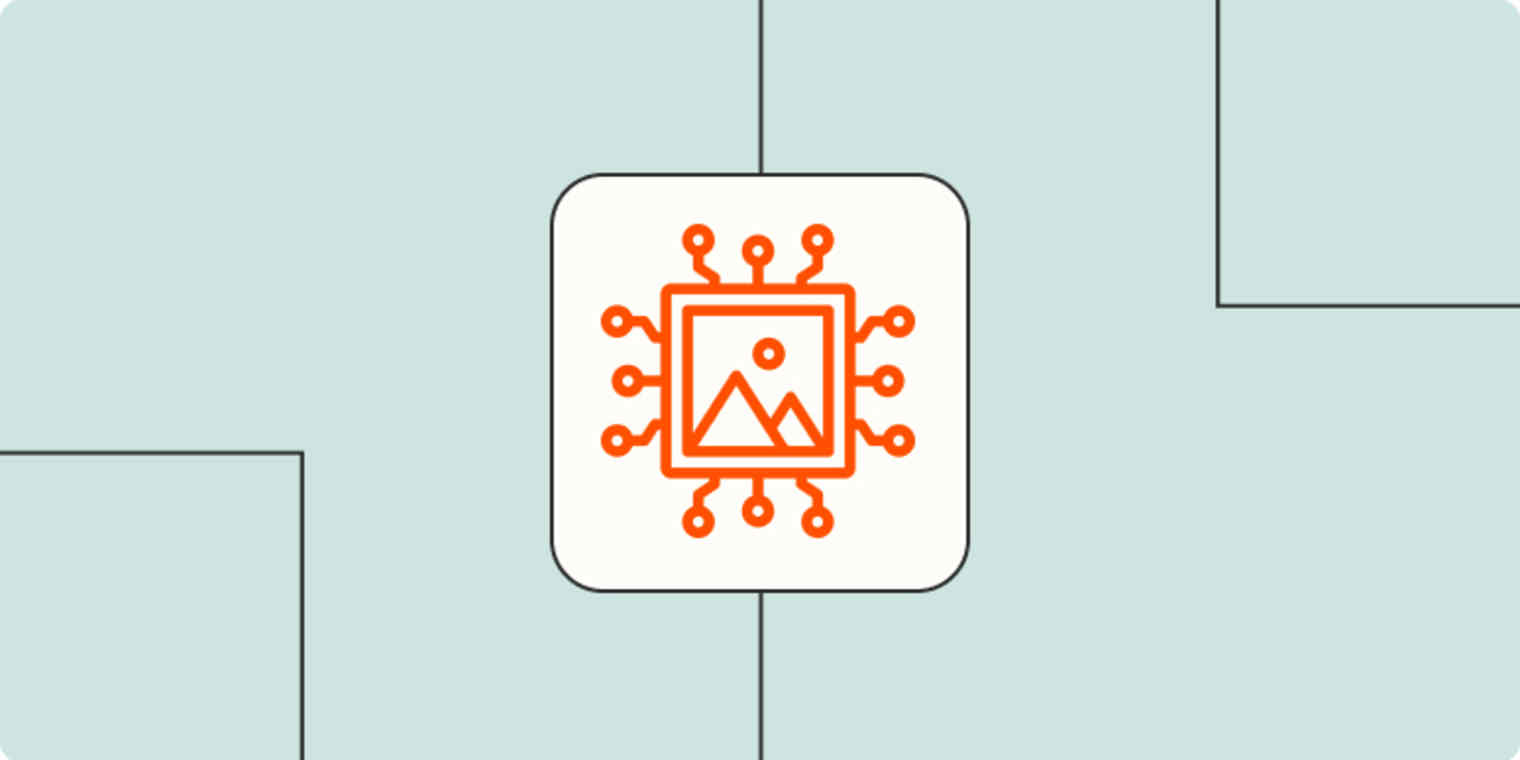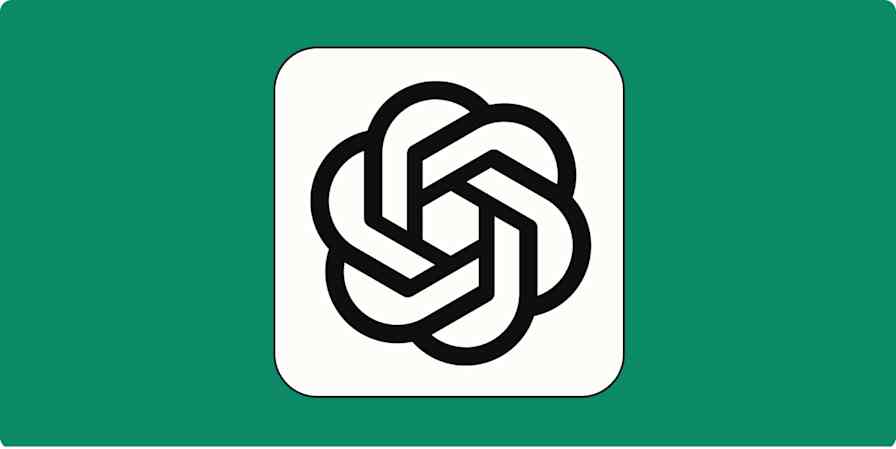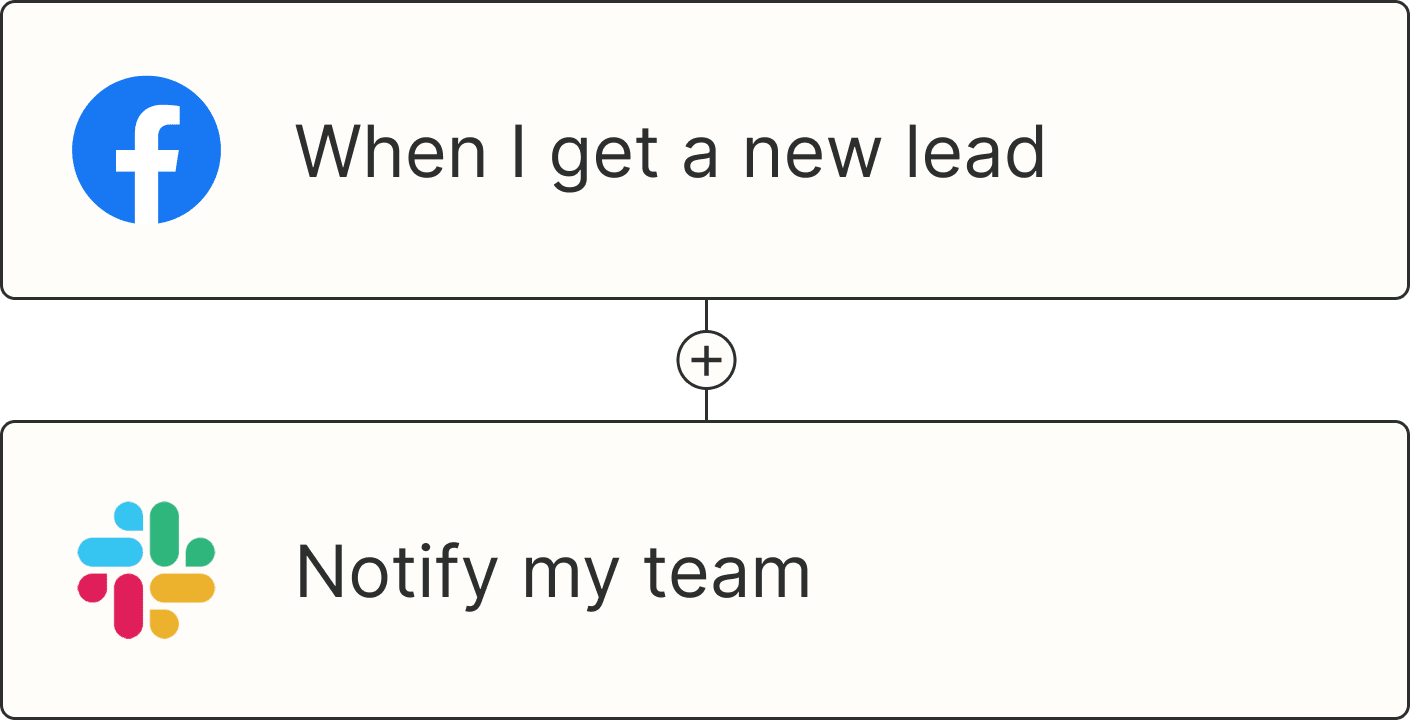In just over two years, text-to-image AI art generators have gone from closed betas to being literally everywhere. What started with DALL·E 2 has grown into a huge cultural movement. AI-powered art generators that have been around for years are having a surge in popularity, and new apps packed with features for professionals are coming on the market. It feels like pretty much everyone is generating amazing, hilarious, and downright weird images, just by typing in a prompt.
If you want to get in on the text-to-image action but aren't sure where to start, this list will help you out. It's a broader list than my picks for the best AI image generators in order to show off all the different angles that folks are taking with AI art generators.
Still, this isn't an exhaustive list of every app that can make AI art. Instead, it shows off the text-to-image AI art generators that worked when I tested them, are accessible through a web app, and seem not to be scams.
The category is changing so fast that by the time you read this, there might be even more great apps available. But for now, it's a pretty good overview of the biggest AI art apps available at the moment.
The top AI art generators
How does AI art work?
The first time you enter a prompt into an AI art generator and it actually creates something that perfectly matches what you want, it feels like magic. But it turns out AI art generators don't work using magic. They use computers, machine learning, powerful graphics cards, and a whole lot of data to do their thing.
Let's break it down.
AI art generators take a text prompt and, as best they can, turn it into a matching image. Since your prompt can be anything, the first thing all these apps have to do is attempt to understand what you're asking. To do this, the AI algorithms are trained on hundreds of thousands, millions, or even billions of image-text pairs. This allows them to learn the difference between dogs and cats, Vermeers and Picassos, and everything else. Different art generators have different levels of understanding of complex text, depending on the size of their training database, and some models are trained for specific purposes or only using licensed content, which affects the kinds of things they can generate.
The next step for the AI is to actually render the resulting image. There are two leading kinds of models:
Diffusion models, like Stable Diffusion, DALL·E 3, Midjourney, and CLIP-Guided Diffusion, which work by starting with a random field of noise, and then editing it in a series of steps to match its understanding of the prompt.
Generative Adversarial Networks (GANs), like VQGAN-CLIP, BigGAN, and StyleGAN, which have been around for a few years longer.
Both kinds of models can produce great, realistic results, though diffusion models are generally better at producing weird or wild images.
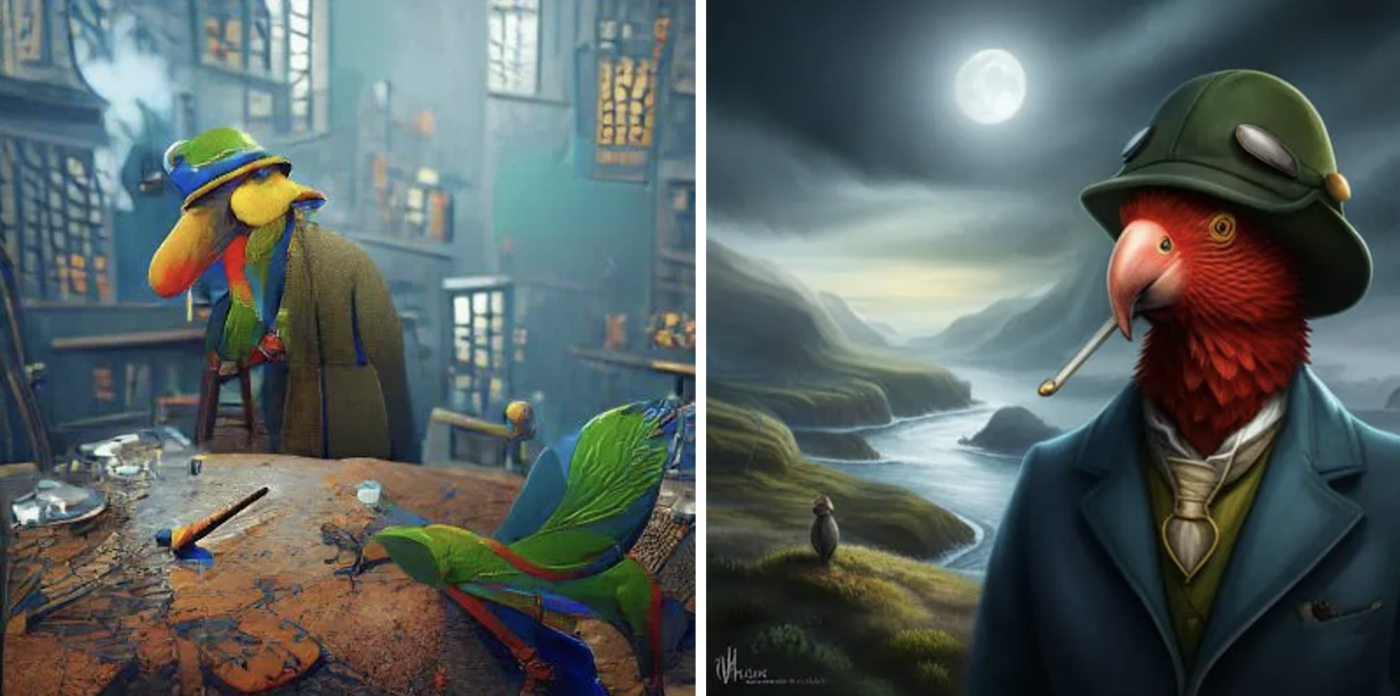
While some apps are very open about which models they use, others obscure it. VQGAN-CLIP and Stable Diffusion, for example, are both open source (or close to it), so there are a large number of apps that use them openly—and lots of others that don't say anything. There are also other apps that use their own data to custom-train various open source models to give better results.
This means that many AI art generators are essentially just different user interface skins for the same art-generating algorithms. From a business point of view, this is somewhat understandable. Still, it's annoying when you're trying to choose which app to use (or write about them). Where possible, I've listed what models each app uses. When it isn't declared, I've speculated, based on my experience with all these different generative AIs.
How to use AI image generation at work
Interested in AI, but not quite sure how you'd use it at work? Here are a few of the ways people are turning to AI image generation in their roles:
Generating hero images for blog posts
Creating social media posts
Generating slide decks and storyboards
Creating personalized images for customers
Learn more about how to use AI image generation at work.
32 AI art generators you can use right now
GPT-4o (ChatGPT)

AI art models: GPT-4o
Platform: Web (via ChatGPT)
Pricing: $20/month as part of ChatGPT Plus
After OpenAI's DALL·E model kicked off the AI image generation boom, it seemed to take a backseat to the company's language models. But now GPT-4o, the model behind ChatGPT, can natively generate images. (You can still use DALL·E as a GPT.)
GPT-4o is one of the best quality image generators available, and it's super easy to use: just tell ChatGPT what you want to see, and it'll create the image. What people seem to love the most is that, if you upload a photo and direct it to create the image in the style of an artist (or, yes, Studio Ghibli), it will do an exceptional job. The only real drawback is that it's a little slow because of the technique it uses to create the images.
You can connect ChatGPT to Zapier to do things like automatically create images from Google Forms or HubSpot responses—or any other apps you use. Learn more about how to automate ChatGPT, or get started with one of these pre-made templates.
Send prompts to ChatGPT for Google Forms responses and add the ChatGPT response to a Google Sheet
Create email copy with ChatGPT from new Gmail emails and save as drafts in Gmail
Zapier is the most connected AI orchestration platform—integrating with thousands of apps from partners like Google, Salesforce, and Microsoft. Use interfaces, data tables, and logic to build secure, automated, AI-powered systems for your business-critical workflows across your organization's technology stack. Learn more.
Reve

AI art models: Reve Image 1.0
Platform: Web
Pricing: Free for 20 credits per day; additional credits are $5/500
Reve Image 1.0 came out of nowhere in March 2025, and its biggest draw is that it sticks to the prompt really closely. This has been tough for image generators, especially as prompts get longer and more complicated, but I was consistently impressed by just how many details Image 1.0 could manage.
The only area it falls short is with editing: it's not as good as GPT-4o or Midjourney at incorporating requested edits. But the credit-based pricing is nice—you can use it with a little more flexibility.
Bing Image Creator
AI art models: DALL·E 3
Platform: Web
Pricing: Free
Bing Image Creator is a result of Microsoft's partnership with OpenAI. It uses the latest DALL·E model, DALL·E 3, and it's free (at least for now). The default styles are a little different, so it's well worth a look, even if you've used DALL·E in the past.
Imagen 3 (Google Gemini)

AI art models: Imagen 3
Platform: Web
Pricing: Included in Google One with AI Premium Plan at $20/month and some Google Workspace plans.
As Gemini is Google's answer to ChatGPT, Imagen is its answer to to DALL·E 3. And yep, it's great. If you already use Google's Gemini chatbot, it's the first art generator you should try. Otherwise, it's worth checking out in any art generator that enables it through its API.
StableAssistant (Stable Diffusion)
AI art models: Stable Diffusion
Platform: Web (through Stable Assistant)
Pricing: From $9/month for 900 image credits
Stable Diffusion is one of the most important open model families. The official way to access the latest version is through Stable Assistant, but I don’t recommend it. The company is going through some major difficulties. Having said that, Stable Diffusion models are available in a lot of other AI art generators (a lot of which I've listed here), and it's well worth using in those.
Midjourney

AI art models: Midjourney
Platform: Web and Discord
Pricing: From $10 for 3.3 hours of GPU time per month (enough for ~200 prompts with 4 image options each)
Now that Midjourney has a real web app, its place as one of the best AI art generators is even more secure. If you're interested in the art and community side of AI art, it's the app to use. It's long been one of my personal favorites because it produces some of the best-looking and most realistic results.
Read the showdown with DALL·E: Midjourney vs. DALL·E.
Ideogram

AI art models: Ideogram 3.0
Platform: Web
Pricing: Free plan with 10 credits/week. From $8/month for 400 credits/month
Ideogram is one of the most powerful AI art generators around. Its app is enough for professionals to create and combine AI and real elements into incredible designs. But Ideogram has one big super power: it's one of the best AI art generators at rendering text.
Leonardo.Ai
AI art models: Phoenix, FLUX.1
Platform: Web
Pricing: Free plan with 150 tokens/day; from $12/month for 8,500 image credits/month
Another powerful art generator, Leonardo.Ai now has its own model called Phoenix. It's a fast, fully-featured, constantly improving art generator that even allows you to fine-tune your own models, or edit images as they generate in real-time on the canvas.
Recraft

AI art models: Recraft
Platform: Web
Pricing: Free for 50 credits/day; from $12/month for 1,000 credits/month
Recraft is an AI art generator for professional graphic designers. In addition to having one of the best AI models around, it's packed with features that make it easy to keep AI generations consistent, export them to other apps, and even create mockups. If you're a pro, it's the app for you.
Dream Machine (Luma Photon)
AI art models: Luma Photon
Platform: Web
Pricing: Free for limited use and watermarks; from $9.99/month for 3,200 credits/month
Luma Photon is a great model. Its Dream Machine app is a little offbeat, but you can try it out for free to see if it works for you.
Playground

AI art models: Playground V3
Platform: Web, iOS
Pricing: Free plan with limited generations and designs; from $15/month for unlimited premium designs and 75 images every 3 hours
Playground has one of the highest rated AI models, and its art generator app is very clever. Instead of just working from a prompt, you choose a template from a huge library of designs and then use AI to edit it so it meets your needs. It's a great way to get the benefits of both human design ability and the speed of AI.
Canva

AI art models: Stable Diffusion
Platform: Web, iOS, Android
Pricing: Free; from $15/month for Pro with more AI features
Canva is a design app, but it also includes a text-to-image art generator. It integrates perfectly with the rest of the template-based app, so you can add AI-generated art and graphics to anything from social media posts to birthday cards.
With Zapier's Canva integration, you can automate your design workflows, automatically creating designs and uploading assets based on activity in other apps. Learn more about how to automate Canva, or get started with one of these pre-made workflows.
Create Canva designs from new or updated Google Sheets rows
NightCafe

AI art models: FLUX.1, Stable Diffusion, DALL·E 3, Imagen 3, and more
Platform: Web
Pricing: From $6/month for 100 credits (enough for ~1,240 images per month)
NightCafe pulls together some of the best AI models, like FLUX.1, Stable Diffusion, DALL·E 3, and Imagen 3, and adds loads of extra features, like styles and model fine-tuning. On top of being a great AI art generator, NightCafe is a community for AI art enthusiasts that includes challenges, a Discord server, and a gallery.
OpenArt
AI art models: FLUX.1, Stable Diffusion, and other open models
Platform: Web
Pricing: Free for 40 trial credits; from $14/month for 4,000 credits
Like NightCafe, OpenArt gives you access to powerful open models like FLUX.1 and Stable Diffusion. It also gives you more control over the specifics of the images you generate than a chatbot-based tool would, and it adds some nice extra features like a bulk generator.
Adobe Firefly
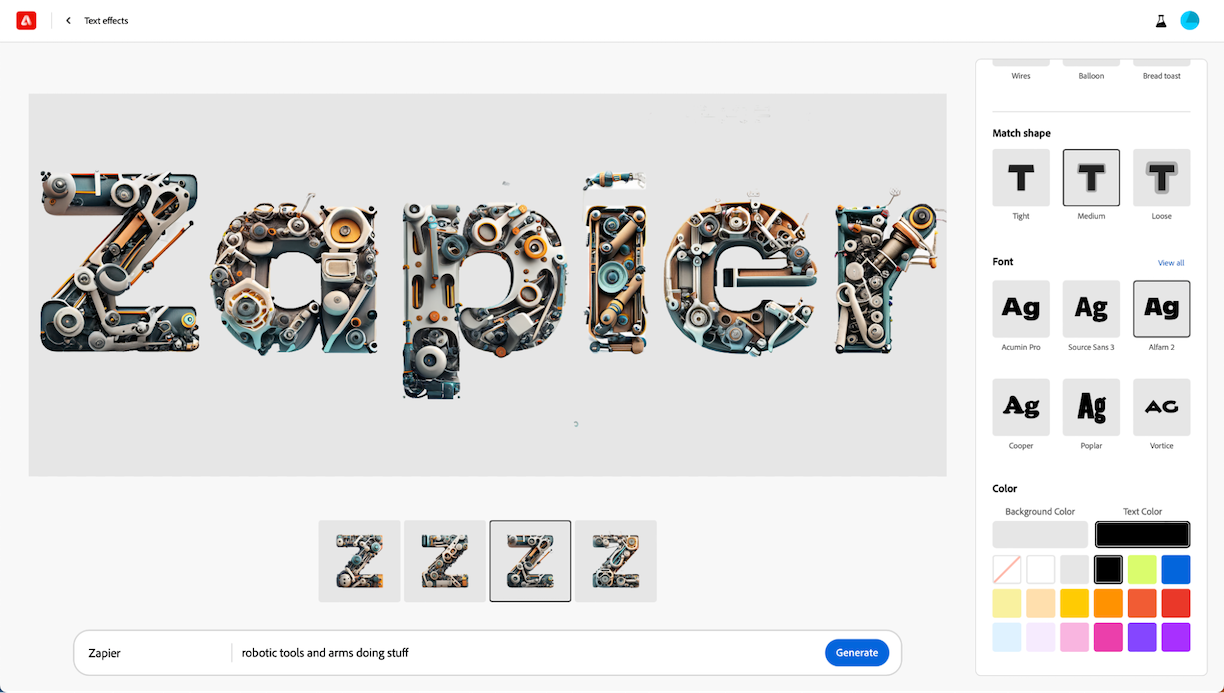
AI art models: Firefly
Platform: Web, Adobe Express, Adobe Photoshop, and other Adobe tools
Pricing: Free for 25 credits per month; from $9.99/month for 2,000 credits per month (and included with various Adobe subscriptions)
Adobe has been an AI company for over a decade, and it shows with its custom AI art generator called Firefly. While you can use it online, it's now being integrated directly into Adobe products like Express and Photoshop.
Perhaps Firefly's best feature is that you can use it to create custom text effects using a written prompt. AI art generators often struggle with text, and Firefly is really the only one that can do this right now.
Prodia
AI art models: FLUX.1, Stable, Diffusion and other open models
Platform: Web
Pricing: Free for unlimited images one at a time
Another Stable Diffusion-based art generator, Prodia stands out by letting you try all its models without having to sign up for an account. Prodia also connects with Zapier, so you can automatically create an image on Prodia based on triggers in your other apps. Here are some examples to get you started.
Create generations in Prodia for new Typeform entries
Create Prodia generations from new Zoho Forms entries for seamless data management
Craiyon

AI art models: Based on original DALL·E model (Not DALL·E 2)
Platform: Web
Pricing: Free; from $12/month for faster images and no watermark
Craiyon (previously DALL·E Mini) was based on the original DALL·E model. It looks to be beta testing a FLUX.1-based model, but the app is still significantly more basic than the latest art generators. Still, it's free and fun to play around with.
getimg.ai
AI art models: FLUX.1, Stable Diffusion, and other open models
Platform: Web
Pricing: Free for 100 images per month; from $12/month for the Basic plan, with 3,000 images/month and the ability to train your own models
getting.ai is an AI art generator app with more than 20 open models, including FLUX.1 and Stable Diffusion (and models built from it, like OpenJourney). The biggest feature, though, is that with a paid plan, you can train your own models.
Shutterstock AI Image Generator
AI art models: Custom
Platform: Web
Pricing: From $7/month for 400 images/month
Stock image company Shutterstock obviously recognizes the existential threat that generative AI poses to its business—so instead of fighting, it's joining. While the Shutterstock AI Image Generator was originally powered by DALL·E 2, it now uses a more powerful custom model.
Generative AI by Getty Images

AI art models: Custom model developed with NVIDIA
Platform: Web
Pricing: Custom
Like Shutterstock, Getty Images has developed an AI art generator.
Generative AI by Getty Images and Generative AI by iStock are trained on Getty and iStock's collections of stock images. This makes them good for generating weirdly specific stock photos, but not as competent or creative at other things.
Best of all, though, Getty claims that its models are free from intellectual property issues, so you're indemnified against any legal claims resulting from using the images you make with its tool. If your company has a legal department, one of these might be that AI art generator you need.
Deep Dream Generator
AI art models: Open and custom-trained models
Platform: Web
Pricing: Free for 3 images/day; from $9/month for the Basic plan, which allows for hundreds of images per month
Deep Dream Generator is one of the oldest AI art generators online. It was originally designed to use Google's DeepDream algorithm but has added text-to-image algorithms like FLUX.1 and custom-trained Stable Diffusion models.
Artbreeder

AI art models: BigGAN, StyleGAN, FLUX.1, and Stable Diffusion
Platform: Web
Pricing: Free for 3 credits/month and most features; from $8.99/month for 100 credits/month (which allows you to use more powerful features more often)
Artbreeder (formerly Ganbreeder) launched in 2018 as a platform for experimenting with generative AIs. It's still loose, experimental, and super art-focused. Its different tools called things like Mixer, Collager, and Splicer allow you to combine aspects of multiple images to create something unique, and work from text prompts.
Stablecog
AI art models: FLUX.1 and other open models
Platform: Web
Pricing: Free for 20 images/day; from $10/month for the Starter plan with 2,000 images/month
Stablecog is another AI art generator based on FLUX.1, Stable Diffusion, and other similar models. It's got a nice, easy-to-use web app and, perhaps best of all, a nice, easy-to-understand pricing structure.
DeepAI
AI art models: Custom models
Platform: Web
Pricing: Free; from $5/month for 500 images
DeepAI is mostly an AI API for developers, but it has a free text-to-image art generator on its website to showcase what it does. You can also sign up for a paid plan, which gives you access to more styles and allows you to use the API.
starryai
AI art models: Open models
Platform: Web, iOS, Android
Pricing: Free for 5 credits/day; from $15/month for 200 credits/month
starryai is another art generator that uses the various open models. It's free for five prompts and twenty images per day, so it's one of the best free ways to try out generative models. There are also mobile apps, which is nice.
Fotor
AI art models: Doesn't say, but probably based on Stable Diffusion
Platform: Web
Pricing: Free for 4 images; from $8.99 for 100 credits
Fotor is a popular online image editing app, and it's recently added a text-to-image art generator that integrates with its editor.
Runway
AI art models: Frames
Platform: Web
Pricing: Free trial; from $15/editor/month for the Standard plan, with 625 credits per month
Runway is a suite of art-generating tools for businesses. In addition to features like multiple seats and shared assets, you can train your own custom models.
WOMBO Dream
AI art models: Doesn't say, but probably Stable Diffusion-based models
Platform: Web, iOS, Android, Discord
Pricing: Free; from $9.99/month for premium features like making multiple outputs from one prompt
Dream by WOMBO is a freemium art generator with a large number of styles. Although it doesn't say explicitly, it likely uses Stable Diffusion-based models to generate its images.
Visual Electric
AI art models: Originally Stable Diffusion-based, but may now be FLUX.1
Platform: Web
Pricing: Free for 20 credits/month; from $20/month for 500 credits/month
Visual Electric is an AI art generator that's tailored to generating photorealistic images. If you need to create stock photos, mockups, and other photo-like images, it's a great option.
Picsart
AI art models: Likely Stable Diffusion-based but also with their own technology
Platform: Web, iOS
Pricing: Free for 5 credits/week; from $13/month for 200 credits/month, no watermarks, and premium features
Picsart is an online image editing app. The AI art generator integrates with the rest of the editor, so you can combine AI-generated elements with text, stickers, and other images. Although it's free to use, you have to pay to download images without a watermark.
CF Studio
AI art models: Doesn't say, but probably Stable Diffusion-based
Platform: Web
Pricing: Free; from $9/month for faster generating and private downloads
Creative Fabrica is a digital assets marketplace that's added an art generator. It's free to use, but its best feature is that you're able to browse hundreds of other AI creations.
LetsEnhance
AI art models: Doesn't say, but appears to be Stable Diffusion-based
Platform: Web
Pricing: Free for 10 credits/month and watermarked images; from $12/month for 100 credits/month
LetsEnhance is an AI-powered image upscaling app that recently added an art generator. If you want super high resolution images, it's the app to use.
Other categories of AI art generators
This list is focused on text-to-image art generators, but there are entire other categories of AI art makers out there. Some examples:
I didn't include API-services, like Replicate and fal, but they're useful if you’re building your own AI art generator.
Lensa's Magic Avatars and MyHeritage's AI Time Machine both take a series of selfies and return AI-generated portraits.
Many chatbots and text-generating apps, like Merlin, Jasper, Writesonic and Rytr, also include AI art generators. If you use one of these, check it out—they mostly use Stable Diffusion and FLUX.1.
I was only looking at web apps in this list, but there are mobile-only art generators like ArtOut, if you just want something on your smartphone.
And then there are others, like Palette, that can colorize photos.
And these are just the AI art generators that are available now. Other companies are certainly testing their own art generators, and you could always train your own using one of the apps I mentioned that allows for that.
Make the most of your AI art
You might be generating AI art for fun—in which case, have at it (and check out these AI photo editors to help make your masterpieces extra pretty). But if you're thinking about using an AI art generator at work, there's plenty you can do with it. Here's some inspiration:
You should also take a peek at Zapier's tips on how to write effective AI art prompts, so you can get the results you want quicker.
Which AI art generator should you use?
With so many AI art generators to choose from, it can be hard to know where to start. So let me break it down:
Midjourney and Recraft are my favorites. Midjourney is the more fun app, but Recraft is more professional and has a free trial.
DALL·E 3 and Imagen 3 are great if you use ChatGPT or Gemini. You can also find them cheaper elsewhere, like DALL·E 3 in the Bing Image Creator.
FLUX.1 and Stable Diffusion are used in lots of different apps.
Firefly's text effects are awesome, as is its integration with other Adobe tools.
NightCafe and OpenArt are the best apps if you want to play around with different models, including some of the older GAN models.
Artbreeder is perhaps the weirdest art generator among a very weird series of art generators—and totally worth a look.
Otherwise, just scroll through the list and try whichever ones strike your fancy. You can't go too far wrong.
Related reading:
This article was originally published in May 2023. The most recent update was in April 2025.
